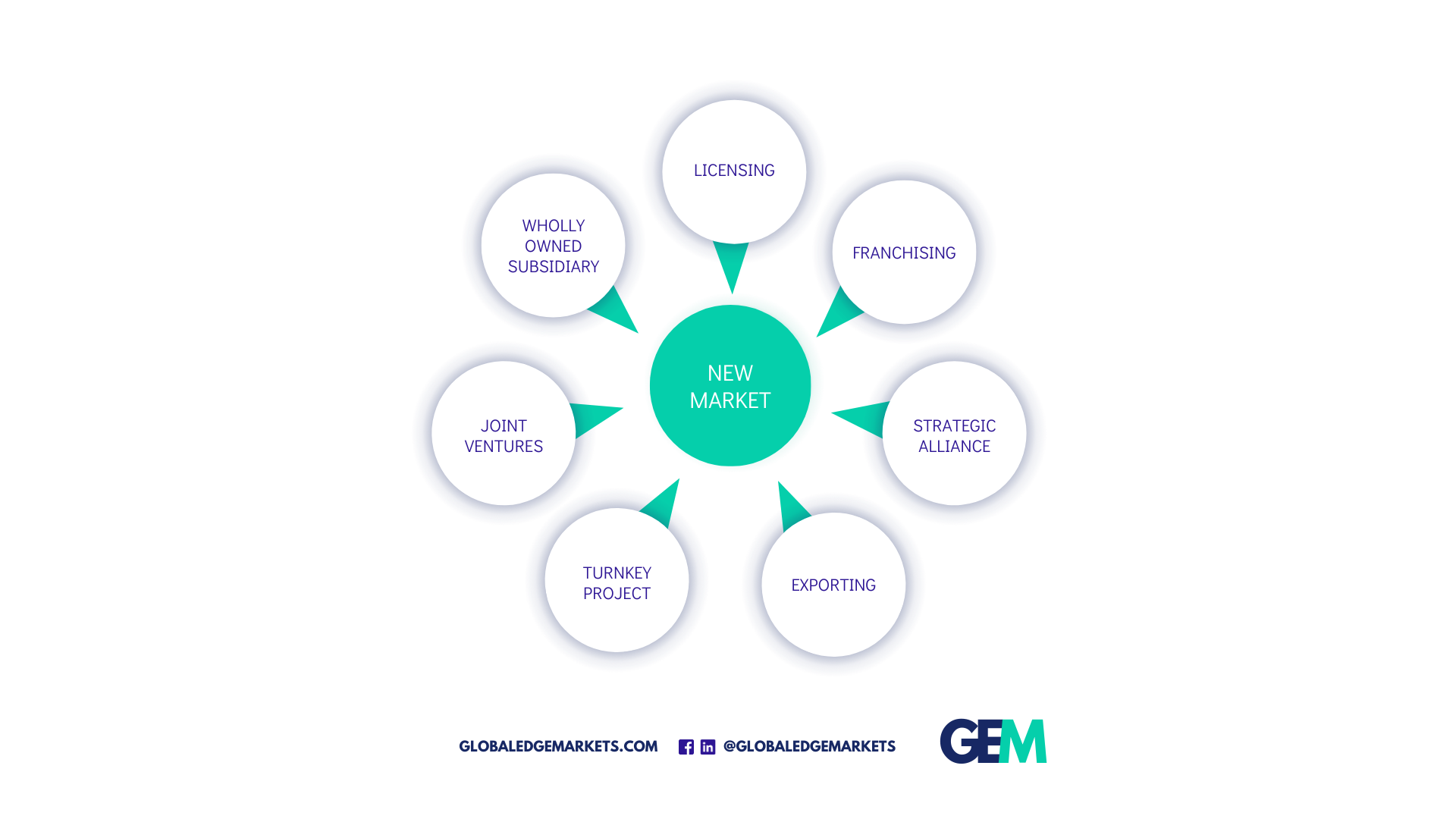Global Market Entry & Expansion Strategy
about the service
Entering New Markets and Expanding Reach
Global market entry strategy refers to the sales and marketing framework you will use to expand globally. It focuses on how you’ll increase product awareness in a new region and what technology, resources, and services you need to distribute your products and gain a foothold in this new market.
Entering new markets can be exciting for start-ups to big-name brands alike. A clearly defined market entry strategy — including the business model, localization needs, and marketing frameworks — can give you a soft landing in a foreign market.
Achieving the strategic growth, you seek and winning in your global market requires an effective market entry strategy, an efficient localization process, and thoughtful execution of a market entry strategy to keep your business ahead of the competition.

some stats
what we can do for you
- Our global market entry and expansion strategy services help you develop a comprehensive framework to support your global business expansion. We specialize in providing customized solutions to get you ready to take your business to the next level. With our expertise, you can develop a powerful strategy to ensure successful market entry and expansion.
- Let us help you develop the perfect sales and marketing solutions to ensure successful market entry and expansion. Our team of experts will provide you with the insight and advice you need to create a comprehensive plan tailored to your company's needs. We will help you identify potential opportunities, target the right audiences, and develop effective sales and marketing solutions for your global expansion.
- To identify potential opportunities for global business expansion, we help you research competitors in the international market and analyze their strengths and weaknesses. Our experts also evaluate relevant customer segments and investigate the preferences of each to ensure you are creating product offerings that will appeal to target audiences.
- We also help you look into regulations, taxes, and other legal requirements for operating in different countries. With careful consideration of all these factors, you can identify the most promising opportunities for global expansion and create a successful strategy for growth.
By actively scouting for potential opportunities in foreign markets and leveraging resources to build a solid strategy for success, your business can expand its operations globally and reap the benefits of a diverse customer base and access to new resources.
Market Entry Strategy
- 74% of businesses that fail to enter a new market do so because of inadequate market research. (Source: Harvard Business Review)
- Market entry strategies tailored to the target market's specific needs are 50% more likely to be successful. (Source: McKinsey & Company)
- Companies that invest in building relationships with local partners are more likely to succeed in new markets. (Source: Deloitte)

Key Considerations for Global (or Domestic) market Entry and Expansion
Before diving into a new market, businesses need to be methodical in their approach. Among the pivotal considerations are:
- Competitive Landscape
Understanding the existing competition allows businesses to find opportunities for differentiation and identify potential challenges in the new market.
Components:
- Direct and Indirect Competitors: Know who you’re up against, both directly and indirectly, and what they offer.
- Market Share: Understand your competitors’ market share to assess the level of market saturation.
- Competitive Advantages: Identify what sets your business apart from the competition, whether it’s pricing, product features, or customer service.
- Financial Considerations
Components:
- Cost of Entry: Factor in all costs related to entering the market, from legal fees to marketing expenditures.
- Revenue Projections: Assess the potential profitability of entering the new market.
- Currency Risks: Understand currency exchange risks, especially if dealing with multiple currencies.
- Budgeting and Resource Allocation: Financial planning is critical in global expansion. The allocation of resources should be strategically planned, balancing the cost of entering a new market against expected returns. Tools like zero-based budgeting can help in this regard.
- Assessing Financial Viability and Return on Investment: An ROI analysis will provide a clear picture of the financial gains your business can expect. Employ financial metrics like Net Present Value (NPV) and Internal Rate of Return (IRR) for a more in-depth understanding.
- Financial Strategies in Times of Economic Uncertainty: Navigating through economic instability requires a robust financial strategy. Hedging against currency risk and diversifying investment portfolios can offer some level of protection.
- Partnerships and Alliances
Partnerships can provide a more accessible pathway into new markets, offering local expertise and shared resources.
- Local Partners: Local businesses can offer invaluable insights into the market and may provide a distribution network.
- Strategic Alliances: Sometimes entering a market is more accessible when done in alliance with another non-competing business.
- Franchising/Licensing: These can be other ways to enter a market with a lower risk profile.
- Supply Chain Logistics
- Local Suppliers: Identify potential local suppliers for raw materials or goods to possibly reduce costs.
- Distribution Channels: Assess the most effective methods for product distribution, whether online or through local retailers.
- Inventory Management: Plan for storage, stocking, and inventory turnover.
- Technology Infrastructure
- E-commerce Capabilities: Understand the online shopping habits and preferred payment methods of the new market.
- Localized Website: Adapt your website and mobile applications to accommodate local languages and customs.
- Data Security: Make sure your technology complies with local and international data protection laws.
- Risk Assessment
Understanding the risks involved helps in better preparation and response planning.
Components:
- Political Risks: Consider the stability of the local political environment.
- Economic Risks: Be aware of economic factors like inflation, interest rates, and economic stability.
- Reputational Risks: Assess how an unsuccessful entry could impact your business’ reputation
- Regulatory Environment
Non-compliance with laws and regulations can lead to severe financial and reputational damage. Ignorance of the law does not excuse a business from the repercussions of legal oversights.
Components:
- Local Laws: Familiarize yourself with the legal obligations related to business operations, including employment, environmental laws, and consumer protection.
- Industry-Specific Regulations: Some industries have specific laws that businesses must adhere to, such as healthcare, financial services, and food and beverages.
- Intellectual Property: Ensure that trademarks, patents, and copyrights are secure and compliant with local laws.
- Cultural Nuances
- Communication Style: Language barriers or specific communication norms can greatly influence marketing materials and customer interactions.
- Social and Religious Factors: Holidays, customs, and religious observances can affect business hours, promotional calendars, and even the types of products or services that are in demand.
- Consumer Behavior: Cultural attitudes towards things like luxury, saving, family, and social responsibility can heavily influence purchasing decisions.
With careful planning, global expansion can be that effective way for your business to grow and become even more successful than before.
from our blog
Related Posts

The Foundation of Entering New Markets
The possibilities are endless when it comes to finding new customers when expanding to new markets. Still, getting that first great connection or opportunity can

The Revolution Is Here — How Generative AI Is Changing the Business World
Do you remember what life was like before smartphones? Perhaps you can even conjure memories of daily life before the internet. Life was simpler, but

The Role of AI in Personalizing Customer Experience Across Global Markets
Artificial Intelligence (AI) is a transformative force in this endeavor, offering unparalleled insights and capabilities to tailor customer experiences. By leveraging AI, startups can navigate the complexities of global consumer behaviors and cultural nuances, ensuring their offerings meet varied customer expectations.



